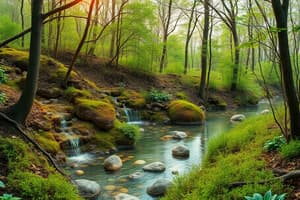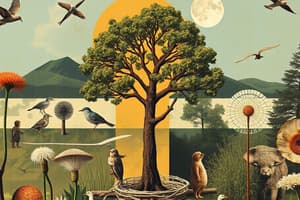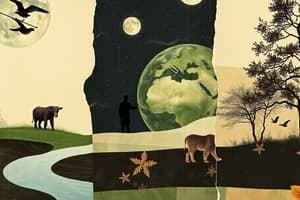Podcast
Questions and Answers
Which of the following correctly describes the relationship between a population and a community?
Which of the following correctly describes the relationship between a population and a community?
- A population encompasses all the non-living components of an area, while a community only includes the living.
- A population includes multiple communities within the same area.
- A community is a group of the same species living in a particular area, while a population refers to all species together.
- A community consists of multiple populations of different species. (correct)
Why is the concept of a 'limiting factor' important in understanding species distribution and survival?
Why is the concept of a 'limiting factor' important in understanding species distribution and survival?
- It determines the maximum potential growth rate of a population under ideal conditions.
- It identifies the factor that restricts the size or distribution of a population by falling outside the species' tolerance range. (correct)
- It describes the optimal condition for a species, ensuring its survival and reproduction.
- It refers to factors that have no impact on an organism's survival.
How do human activities primarily disrupt the carbon cycle, and what is a major consequence of this disruption?
How do human activities primarily disrupt the carbon cycle, and what is a major consequence of this disruption?
- By increasing the amount of carbon dioxide in the atmosphere through deforestation and burning fossil fuels, contributing to climate change. (correct)
- By reducing the amount of carbon dioxide in the atmosphere, leading to a decrease in global temperatures.
- By enhancing the rate of carbon sequestration in the soil, which helps to balance carbon levels in the atmosphere.
- By increasing the absorption of carbon dioxide by plants through widespread reforestation efforts.
In an ecosystem, approximately what percentage of energy is transferred from one trophic level to the next, and what happens to the rest?
In an ecosystem, approximately what percentage of energy is transferred from one trophic level to the next, and what happens to the rest?
Which type of symbiotic relationship benefits one species while harming the other, and what is an example of this relationship?
Which type of symbiotic relationship benefits one species while harming the other, and what is an example of this relationship?
What is the key difference between primary and secondary ecological succession?
What is the key difference between primary and secondary ecological succession?
Why is species diversity important for the stability and resilience of an ecosystem?
Why is species diversity important for the stability and resilience of an ecosystem?
When a population exceeds the carrying capacity of its environment, what is the most likely outcome?
When a population exceeds the carrying capacity of its environment, what is the most likely outcome?
Which human activity has the least impact on reducing biodiversity?
Which human activity has the least impact on reducing biodiversity?
How does greater participation in environmental science fieldwork help students?
How does greater participation in environmental science fieldwork help students?
What is a key difference in how populations are visualized using population pyramids for young, growing populations versus aging populations?
What is a key difference in how populations are visualized using population pyramids for young, growing populations versus aging populations?
Which factor generally leads to lower birth rates in a population?
Which factor generally leads to lower birth rates in a population?
How do governments manage population growth indirectly?
How do governments manage population growth indirectly?
What is the relationship between poverty and rapid population growth?
What is the relationship between poverty and rapid population growth?
Why are consumption patterns in wealthy nations considered unsustainable?
Why are consumption patterns in wealthy nations considered unsustainable?
How does urbanization contribute to environmental challenges?
How does urbanization contribute to environmental challenges?
What is the core principle of sustainable development as defined in the Brundtland Report?
What is the core principle of sustainable development as defined in the Brundtland Report?
Why is sustainable living crucial for the future, according to the module?
Why is sustainable living crucial for the future, according to the module?
Which of the following correctly describes a renewable natural resource?
Which of the following correctly describes a renewable natural resource?
What is the key difference between consumptive and non-consumptive use of natural resources?
What is the key difference between consumptive and non-consumptive use of natural resources?
Why is biodiversity considered a valuable natural resource?
Why is biodiversity considered a valuable natural resource?
Which factor primarily affects how natural resources are sustainably used in the Caribbean?
Which factor primarily affects how natural resources are sustainably used in the Caribbean?
How does soil degradation affect the long-term productivity of a landscape?
How does soil degradation affect the long-term productivity of a landscape?
What is the purpose of conservation efforts concerning natural resources?
What is the purpose of conservation efforts concerning natural resources?
Which economic tool can governments use to sustainably influence resource use?
Which economic tool can governments use to sustainably influence resource use?
Why is integrated development planning important for sustainable natural resource use?
Why is integrated development planning important for sustainable natural resource use?
What is the vital purpose of Environmental Impact Assessments (EIAs)?
What is the vital purpose of Environmental Impact Assessments (EIAs)?
How does ecotourism support conservation efforts?
How does ecotourism support conservation efforts?
What role do indigenous communities have in natural resource management?
What role do indigenous communities have in natural resource management?
Which international agreement focuses on protecting species, habitats, and genetic diversity?
Which international agreement focuses on protecting species, habitats, and genetic diversity?
Which process supports ecological processes through the recycling of nutrients and matter?
Which process supports ecological processes through the recycling of nutrients and matter?
What happens in assimilation?
What happens in assimilation?
Which of the following best describes a fundamental niche?
Which of the following best describes a fundamental niche?
Which of the following is an example of commensalism?
Which of the following is an example of commensalism?
How does natural selection lead to adaptation in organisms?
How does natural selection lead to adaptation in organisms?
Which population sampling method is best suited to a species which is able to move around?
Which population sampling method is best suited to a species which is able to move around?
How could a student measure the biodiversity present in a community?
How could a student measure the biodiversity present in a community?
Flashcards
Ecology
Ecology
Study of living organisms' interaction with each other and their environment.
Species
Species
A group of organisms that can reproduce with one another.
Population
Population
Group of the same species living in a particular area.
Community
Community
Signup and view all the flashcards
Ecosystem
Ecosystem
Signup and view all the flashcards
Biosphere
Biosphere
Signup and view all the flashcards
Habitat
Habitat
Signup and view all the flashcards
Niche
Niche
Signup and view all the flashcards
Biome
Biome
Signup and view all the flashcards
Ecotone
Ecotone
Signup and view all the flashcards
Abiotic Factors
Abiotic Factors
Signup and view all the flashcards
Biotic Factors
Biotic Factors
Signup and view all the flashcards
Tolerance Range
Tolerance Range
Signup and view all the flashcards
Limiting Factor
Limiting Factor
Signup and view all the flashcards
Fundamental Niche
Fundamental Niche
Signup and view all the flashcards
Realized Niche
Realized Niche
Signup and view all the flashcards
Biogeochemical Cycles
Biogeochemical Cycles
Signup and view all the flashcards
Carbon Cycle
Carbon Cycle
Signup and view all the flashcards
Nitrogen Fixation
Nitrogen Fixation
Signup and view all the flashcards
Phosphorus Cycle
Phosphorus Cycle
Signup and view all the flashcards
Water Cycle
Water Cycle
Signup and view all the flashcards
Energy Flow
Energy Flow
Signup and view all the flashcards
Producers
Producers
Signup and view all the flashcards
Primary Consumers
Primary Consumers
Signup and view all the flashcards
Secondary Consumers
Secondary Consumers
Signup and view all the flashcards
Decomposers
Decomposers
Signup and view all the flashcards
Food Chain
Food Chain
Signup and view all the flashcards
Food Web
Food Web
Signup and view all the flashcards
Trophic Level
Trophic Level
Signup and view all the flashcards
Ecological Pyramid
Ecological Pyramid
Signup and view all the flashcards
Competition
Competition
Signup and view all the flashcards
Predator-Prey
Predator-Prey
Signup and view all the flashcards
Symbiosis
Symbiosis
Signup and view all the flashcards
Parasitism
Parasitism
Signup and view all the flashcards
Commensalism
Commensalism
Signup and view all the flashcards
Mutualism
Mutualism
Signup and view all the flashcards
Ecological Succession
Ecological Succession
Signup and view all the flashcards
Primary Succession
Primary Succession
Signup and view all the flashcards
Secondary Succession
Secondary Succession
Signup and view all the flashcards
Climax Community
Climax Community
Signup and view all the flashcards
Study Notes
- Ecology is the study of interactions between living organisms and their environment
Ecological Terms
- A species is a group of organisms capable of reproducing with each other
- A population is a group of the same species living in a particular area
- A community refers to all the populations living together in a specific area
- An ecosystem includes living organisms and non-living components like soil, air, and water
- The biosphere is the global sum of all ecosystems, including the atmosphere, lithosphere, and hydrosphere
- Organisms occupy specific habitats (where they live) and fulfill niches (what they do) within ecosystems
- A biome is a large area with similar climate, plants, and animals
- An ecotone is the transition zone between two ecosystems
Biotic and Abiotic Factors
- Living (biotic) and non-living (abiotic) factors constantly interact
- Abiotic factors include sunlight, temperature, water, pH, and soil type
- Biotic factors include plants, animals, fungi, and microorganisms
- Every species has a tolerance range for each abiotic factor, which defines the conditions it can survive
- A limiting factor restricts the success of an organism when it falls outside the organism’s tolerance range
- An organism’s fundamental niche is the full range of environmental conditions it could occupy
- An organism’s realized niche is the smaller range of conditions it actually occupies due to competition or other limitations
Biogeochemical Cycles
- Ecological processes are driven by cycles that recycle nutrients and matter
- Biogeochemical cycles include the carbon, nitrogen, phosphorus, and water cycles
- In the carbon cycle, carbon moves through the atmosphere (as carbon dioxide), living things (through photosynthesis and respiration), and soil (through decomposition)
- Human activities like burning fossil fuels add more CO₂ to the atmosphere, contributing to climate change
- The nitrogen cycle includes processes like nitrogen fixation (bacteria turning nitrogen gas into usable compounds), nitrification, assimilation, and denitrification
- The phosphorus cycle moves slowly because phosphorus is usually found in rocks and soil
- Weathering releases phosphorus into soil, which plants absorb
- The water cycle involves evaporation, condensation, precipitation, runoff, and infiltration
Energy Flow in Ecosystems
- Energy flows in one direction: from the sun, to producers (plants), to consumers and decomposers
- Plants convert sunlight into energy through photosynthesis, making them producers
- Herbivores eat plants and are known as primary consumers
- Carnivores that eat herbivores are secondary consumers
- Decomposers like fungi and bacteria break down dead material, returning nutrients to the soil
- Energy moves through food chains and food webs, and organisms exist at different trophic levels
- At each level, about 90% of energy is lost as heat or used up, and only 10% is passed to the next level
- Ecological pyramids (energy, biomass, numbers) illustrate this energy loss
Biotic Interactions
- Within communities, species interact in various ways (biotic interactions)
- Competition occurs when organisms vie for the same resources like food or space
- Predator-prey relationships involve one organism eating another (e.g., hawk eating a mouse)
- Symbiosis refers to close relationships between species
- Parasitism: one benefits, the other is harmed (e.g., ticks on dogs)
- Commensalism: one benefits, the other is unaffected (e.g., barnacles on whales)
- Mutualism: both benefit (e.g., bees pollinating flowers)
- These relationships shape community structure and ecosystem stability
Ecological Succession
- Ecosystems are self-sustaining systems
- Through ecological succession, ecosystems naturally develop and change over time
- Primary succession: life colonizes bare areas like volcanic rock
- Secondary succession: life returns to an area that was disturbed, like after a fire
- Eventually, the ecosystem reaches a stable state called the climax community, which is balanced and self-regulating
Adaptation
- Organisms adapt to their environments over generations through natural selection
- Proposed by Charles Darwin, natural selection explains that individuals with favorable traits survive and reproduce, passing those traits on
- Over time, this leads to adaptation, where species become better suited to their environments
- Example: cacti have thick skins to store water in deserts
Population Studies
- Ecologists use various methods to study populations
- Population sampling methods include quadrats, transects, and mark-recapture techniques
- These help estimate population sizes and understand distribution patterns
- Species diversity measures how many species are in an area and how evenly distributed they are
- A diverse ecosystem is usually more stable and resilient
- The Simpson’s Diversity Index is one method of measuring biodiversity
Population Growth
- Population growth in natural ecosystems depends on birth rate, death rate, immigration, and emigration
- If resources are plentiful, populations grow exponentially, but they eventually hit environmental resistance like limited food or disease
- The carrying capacity is the maximum population size an environment can support without damage
- If populations exceed this limit, they may crash
Human Impact on Ecosystems
- Humans are part of ecosystems and depend on them for survival
- Natural ecosystems provide food, water, clean air, medicine, and climate regulation
- Human actions such as deforestation, pollution, and habitat destruction disrupt these ecosystems and reduce biodiversity
- Maintaining the integrity of ecosystems is essential for sustainable development
Environmental Observation and the Scientific Method
- Students of environmental science are encouraged to observe ecosystems firsthand, visiting different environments (terrestrial and aquatic)
- Measuring abiotic factors (temperature, pH, and salinity) and analyzing data using charts, graphs, and tables is essential
- Learning how to apply the scientific method — forming hypotheses, collecting and analyzing data, and drawing conclusions — is also a key skill
Human Population Dynamics
- Humans are deeply connected to the environment biologically, socially, and economically
- Human population growth has exploded in recent centuries, particularly since the Industrial Revolution
- Understanding this growth requires examining demographic trends, environmental impacts, and possible solutions
People and the Environment
- People rely on the environment for food, water, shelter, and clothing
- People have adapted to different environments through agriculture, housing types, and cultural practices
- Abiotic factors like climate and soil, and biotic factors like available food and other humans, affect where and how people live
- Dependence on ecosystems is total, as they provide clean air, water, materials, and spiritual well-being
- Population growth often puts too much pressure on ecosystems
Demographic Indicators
- Population studies use demographic indicators to measure and understand population trends
- Fertility rate: the average number of children a woman has
- Mortality rate: the number of people who die per 1,000 each year
- Life expectancy: the average age a person is expected to live
- Immigration (coming in) and emigration (leaving) also affect population size
- Doubling time: the number of years it would take for a population to double at its current growth rate
- Visualize these statistics using population pyramids, graphs showing age and sex distribution
Population Growth Trends
- Historically, the human population grew very slowly
- Industrialization and advancements in medicine, sanitation, and agriculture have caused death rates to fall and populations to grow rapidly
- Today, countries like India and Nigeria continue to grow fast, while others like Japan and Germany have slowed down and even started shrinking
- Geographical distribution of growth affects global resource use and environmental pressure
Calculating Population Growth
- Calculate population growth by subtracting the death rate from the birth rate and adding net migration (immigrants minus emigrants)
- Annual growth rates, percentage increases, and doubling time give a clearer picture
- These calculations help countries plan for the future
Factors Influencing Population Growth Rates
- Women’s education and empowerment generally lead to lower birth rates
- Access to family planning, healthcare, and jobs contributes to smaller families
- In places where children are seen as economic assets or where religious beliefs discourage contraception, populations tend to grow faster
- Economic development, urbanization, and the availability of retirement benefits also affect people’s choices about having children
Population Control Measures
- Governments often use population control measures to manage growth
- Direct measures: providing access to contraceptives and education
- Indirect measures: improving women's rights and economic opportunities
- Natural events like earthquakes or pandemics reduce populations but are not controlled
Population Growth and Poverty
- A strong connection exists between population growth and poverty
- When populations grow faster than resources, people struggle to meet basic needs
- Indices of poverty include access to food, clean water, shelter, healthcare, and education
- Economic indicators like GDP per capita, Gross National Product (GNP), the Human Development Index (HDI), and the Gender Development Index (GDI) show how well a country is doing
- Fast-growing populations can stress schools, hospitals, land, and jobs
Consumption Patterns
- People in wealthier nations consume much more than those in poorer nations
- High consumption leads to more waste, more pollution, and greater greenhouse gas emissions
- Current consumption patterns, especially in developed nations, are not sustainable
Environmental Consequences of Overpopulation and Overconsumption
- Overexploitation of resources like forests and fisheries
- Habitat destruction from urban expansion
- Pollution from industries and vehicles
- Introduction of exotic species that can damage ecosystems
- Ecosystems can collapse when too many resources are removed or natural systems change too quickly
Solutions for Reducing Environmental Impact
- Change lifestyles by reducing waste, choosing sustainable products, and conserving energy
- Use substitutes like bamboo instead of plastic, or solar power instead of fossil fuels
- Utilize environmentally friendly technologies like electric cars and water-saving devices
- Emphasize resource efficiency: using only what is needed and reusing or recycling whenever possible
Urbanization
- Urbanization is the movement of people into cities
- Urban areas can improve access to services but also create problems like overcrowding, poor waste disposal, and pollution
- Rapid, unplanned urbanization often results in slums and informal settlements that lack basic infrastructure
Sustainable Development
- Sustainable development means meeting the needs of the present without compromising the ability of future generations to meet theirs
- Balances environmental health, economic growth, and social well-being
- Population growth and rising consumption put pressure on this balance
Global Initiatives for Sustainability
- The 1987 Brundtland Report (Our Common Future) introduced the idea of sustainable development
- Key part of global conferences like the 1992 Earth Summit (Rio Conference) and the 2002 World Summit on Sustainable Development
- Events stressed managing population growth, protecting biodiversity, and reducing poverty
Natural Resources
- Natural resources include everything we use from the environment such as fresh air, water, forests, fish, soil, and minerals
- Understanding and protecting natural resources is essential for a secure and environmentally responsible future
Types of Natural Resources
- Natural resources are materials and features of the environment that humans use for survival, development, and recreation
- Renewable resources replenish naturally over time if managed properly (sunlight, wind, freshwater)
- Non-renewable resources cannot be replaced on a human timescale (coal, oil, natural gas)
- Exhaustible resources can run out if overused (fish and forests)
- Inexhaustible resources are essentially unlimited (sunlight)
Resource Use
- Resources are used consumptively (directly using up the resource) and non-consumptively (benefiting without depleting)
- Responsible management of both types of use is key to sustainability
Caribbean Natural Resources
- A wide variety of valuable natural resources exist in the Caribbean
- Biodiversity (genetic, species, ecosystem diversity)
- Water (rivers, lakes, aquifers)
- Minerals and hydrocarbons (bauxite, oil, natural gas)
- Landforms (beaches, mountains)
- These resources are essential for food, jobs, health, cultural identity, and economic development
Importance of Natural Resources
- Support livelihoods such as farming, fishing, and tourism
- Major foreign exchange earners through exports and tourism
- Provide food security, raw materials, medicine, recreation, and spiritual or cultural value
- Some resources have intrinsic value, meaning they’re important simply because they exist
Factors Affecting Resource Use
- Political factors: government policies related to development and environmental protection
- Economic factors: foreign investment, national debt, and pressure to export raw materials
- Tourism, agriculture, mining, and manufacturing use up resources and often harm the environment
Environmental Impacts of Poor Resource Management
- Overharvesting and habitat destruction can cause species extinction
- Deforestation removes habitats for birds, insects, and mammals
- Water resources are at risk from pollution, overuse, and poor watershed management
- Mining and oil extraction cause major landscape changes and pollution
- Soil degradation happens when land is overused, leading to erosion and nutrient loss
- Beaches erode due to construction or sand mining
- Coral reefs suffer damage from pollution and climate change
- These issues reduce the long-term productivity and beauty of the Caribbean landscape
Conservation of Natural Resources
- Conservation includes managing, restoring, preserving, and protecting natural areas
- Conservation can happen in situ (on-site) or ex situ (off-site)
Tools for Sustainability
- Sustainable Yield Management: using renewable resources at a rate that allows them to replenish
- Use of substitutes: replacing non-renewables with alternatives (e.g., bamboo instead of plastic)
- Recycling: reusing materials to reduce waste and resource extraction
- Economic tools: governments can charge user fees, offer incentives, or impose penalties
- Environmental accounting: including environmental costs in national budgets and business decisions
- Land-use planning: zoning areas for specific uses
- Integrated Development Planning and Integrated Coastal Zone Management: balancing development and conservation
- Environmental Impact Assessment (EIA): predicting and reducing negative environmental effects before projects are approved
- Protected areas: national parks, marine reserves, and wildlife sanctuaries, with classifications by the IUCN
- Community-Based Natural Resource Management: involving local people in planning and protection Education and awareness: schools, media, campaigns, and training
International Agreements
- UNFCCC: focuses on reducing greenhouse gas emissions and climate change
- CBD (Convention on Biological Diversity): aims to protect species, habitats, and genetic diversity
- UNCCD (Convention to Combat Desertification): works to prevent soil loss and land degradation
- SPAW: protects species and ecosystems in the Wider Caribbean
- Ramsar Convention: protects wetlands of international importance
- MARPOL: prevents pollution from ships
Indigenous Peoples and Natural Resource Management
- Indigenous communities have practiced sustainable methods for generations
- Slash-and-burn agriculture with field rotation
- Collection of non-timber forest products
- Traditional fishing techniques that preserve fish populations
- These practices show us that people and nature can live in harmony
Studying That Suits You
Use AI to generate personalized quizzes and flashcards to suit your learning preferences.




